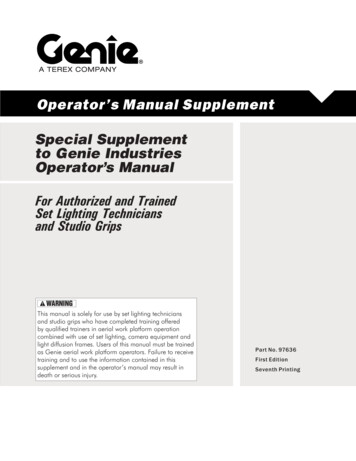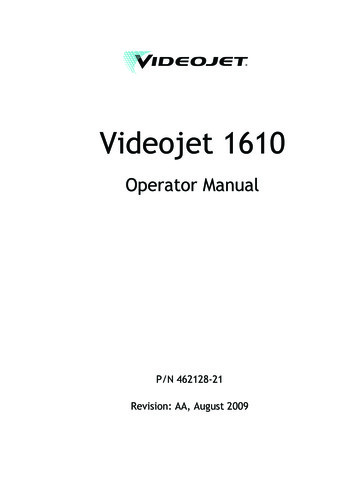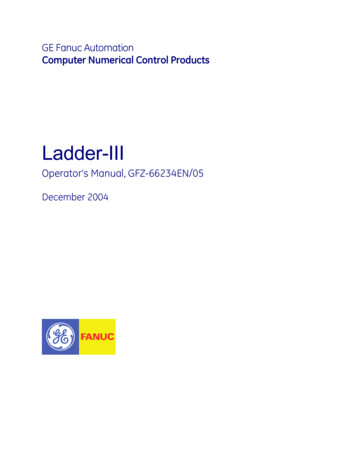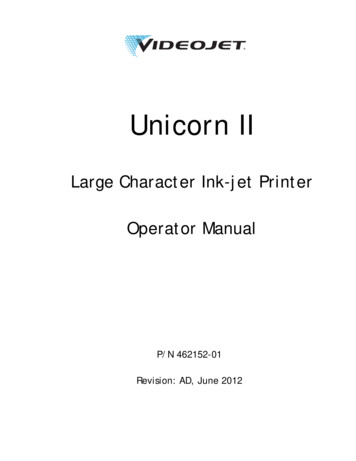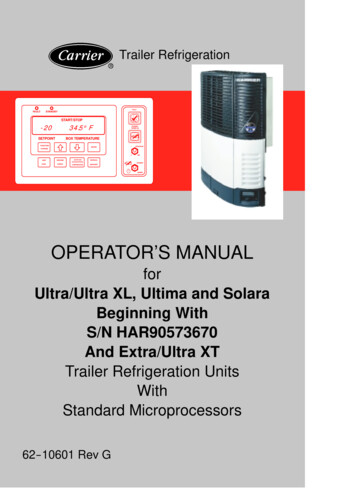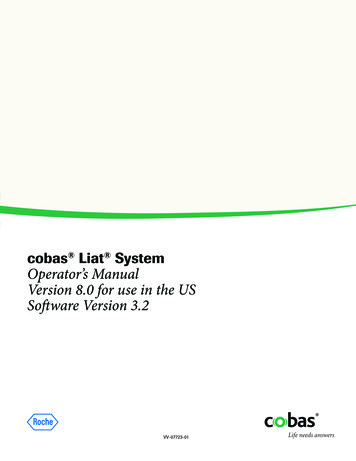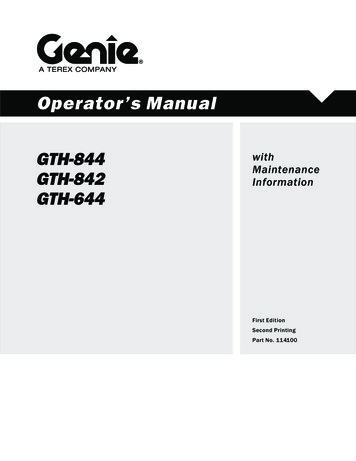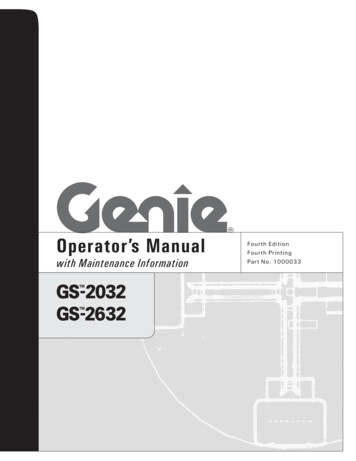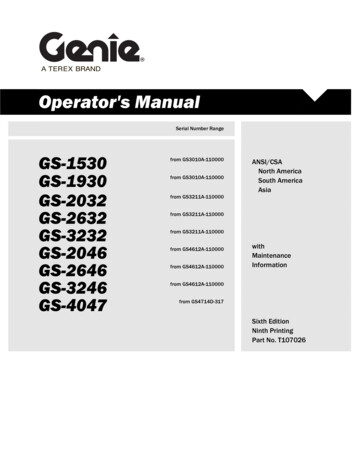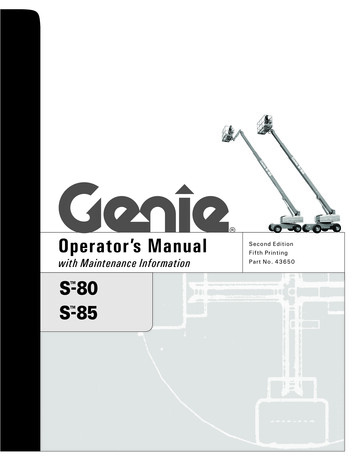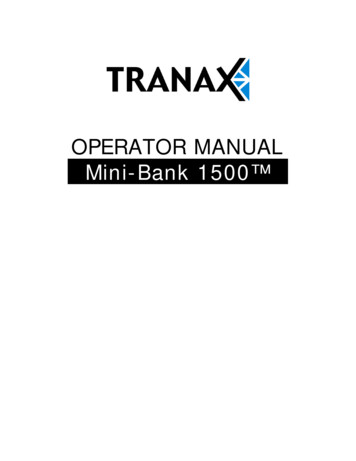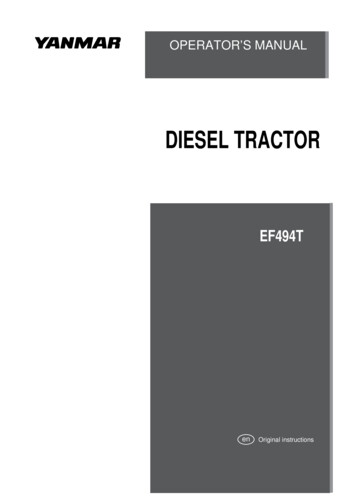
Transcription
OPERATOR’S MANUALDIESEL TRACTOREF494TenOriginal instructions
EF494T OMSAFETYNever attempt to operate or service this machine until you have first read andunderstood all of the applicable Safety Instructions that are set forth in thisManual.The failure to comply with all relevant Safety Instructions could result in bodilyinjury.
EF494T OMTO THE OWNERThis instruction manual describes how to maintain your tractor in good condition and how tooperate it safely and correctly. Please read this manual carefully before using the tractor. Keepthis manual close to your tractor, after you have read through it. If you lose or damage thismanual, ask your YANMAR dealer for a new manual right away.IMPROVEMENTSometimes parts are changed to improve or upgrade the features of the tractor, or for otherreasons. Therefore, the parts shown in this manual may not apply to your tractor.Note: All data are subject to change without prior warning. Some illustrations and photographsmay show optional accessories. A Roll-over Protective Structure (ROPS) is optional.SYMBOLS USED1. Safety-alert SymbolThis is the safety-alert symbol. When you seethis symbol on your tractor or in this manual, bealert to the possibility of personal injury andcarefully read the messages that follow.2. Signal WordsThe signal words "DANGER" "WARNING""CAUTION" are used with the safety-alert symbol.(1) "DANGER" indicates an imminently hazardoussituation which, if not avoided, will result in deathor serious injury.(2) "WARNING" indicates a potentially hazardoussituation which, if not avoided, could result indeath or serious injury.(3) "CAUTION" indicates a potentially hazardoussituation which, if not avoided, could result inminor or moderate injury.3. Service instructions(1) This stop symbol indicates important properoperation or service messages in this manual.When you see this symbol, carefully read themessages that follow.(2) “NOTE” describes precautions to take whileworking.4. MeasurementsThis tractor is of metric design. All hardware aretherefore metric (ISO). Make sure to use thespecified metric hardware when service becomesnecessary.5. DirectionRight-hand and Left-hand sides of the tractor aredetermined by facing in the direction of the tractorforward travel.IMPORTANTNOTE
EF494T OMTABLE OF CONTENTSSAFETY INSTRUCTIONSAFTER SALES SERVICE AND WARRANTYAfter sales serviceAvailability of spare parts1151515PART NAMES19SAFETY LABEL LOCATION21FUNCTION OF EACH CONTROL22EngineTraveling, PTO related functionsHydraulic systemOthersPRE-OPERATION CHECKS1. Pre-operation checks2. Breaking in the engine (first 50 hours)3. Starting and stopping engine4. Raising or lowering implement5. Adjusting lowering speed for implement6. Starting and stopping7. Traveling on the load8. Traveling on the slope9. Power steering10. Driving in and out of Fields11. Setting an adequate speed12. Turning in a field13. Position control14. Using differential lock15. Loading and unloading16. Adjusting wheel tread17. Hydraulic output18. Using 3-point link19. Adjusting top link20. Mounting general farm implements21. Notes on using service implement22. Using PTO shift lever23. Using drawbar hitch24. Safety frame (ROPS)AFTER 141414242444546474849495051After operationOpening the bonnet and side coversChecking and supplying fuelCare for long period of storage51515253PERIODIC INSPECTION AND ADJUSTMENT541. Check intervals2. Oil and grease3. Oil and water volume4. Replacing oil5. Replacing oil filter elements6. Engine coolant7. Fuel line8. Replacing radiator screen and air cleaner elements9. Checking battery10. Checking fluid lines11. Checking electrical wiring12. Greasing13. Adjusting brake14. Adjusting clutch5556565658596061626363646768
EF494T OM15.16.17.18.19.20.Adjusting steering wheelAdjusting fan beltAdjusting tow-inReplacing fuseChecking tiresColor of exhaust gasTROUBLESHOOTING1.2.3.4.Engine partsClutch, brake and related partsHydraulic systemElectric ENT CAPACITIES75
EF494T OMSAFETY INSTRUCTIONSDANGERRead these instructions carefully.Important instructions are given for the safe operationand servicing of the tractor.Failure to follow these instructions is likely to result in anaccident involving death or serious injury.STUDY THE TRACTOR AND IMPLEMENTSDo not permit anyone unfamiliar with the tractor or theoperations of its implements to use the machine.The operator’s manual should be considered apermanent part of the tractor and should remain with thetractor.Know the positions and functions of all controls and themeaning of any identification symbols on your controls,gauges, and indicators before attempting to operate thetractor.Know how to stop the engine in an emergency.Make sure you understand the capabilities, operatingcharacteristics and limitations of the tractor andimplement, such as maximum ballast weight, hydrauliclifting capacity, speed, turning radius, operatingclearances etc.Do not add extra ballast weight to compensate for a loadthat is too heavy.1
EF494T OMPROTECT OPERATOR SAFELYInstall an approved Roll-over Protective Structure(ROPS) for safe operation. If a tractor rolls over withouta ROPS, death or serious injury is likely.Always fasten the seat belt while operating the tractorwith Roll-over Protective Structure (ROPS) up.Do not use the seat belt if the foldable Roll-overProtective Structure (ROPS) is in the folded position orthe tractor does not have the Roll-over ProtectiveStructure (ROPS).Extreme caution is required when operating a tractoraround trees or other overhead obstructions, such asguy wires or power lines. Interference between theROPS and these obstructions may cause the tractor totip backwards.Do not modify any structural portions of the ROPS bywelding, bending, grinding or cutting them. If anycomponent of the ROPS is damaged or involved in arollover incident, replace it with a complete new cage.Do not attempt to repair the original one. Damaged ormodified structural parts impair the strength of theROPS and may lead to injury.Avoid loose fitting or baggy clothing, torn clothing,bulging pockets, frayed edges or heavy cuffs. Loosefrayed and bulky clothing can easily become entangledin rotating parts. Wear work clothes and work shoes orboots. Also you may need a: SAFETY HELMET,SAFETY SHOES, EYE PROTECTION, HEAVY DUTYGLOVES, HEARING PROTECTION, REFLECTIVECLOTHING, OR A RESPIRATOR/FILTER MASK.Wear whatever safety gear and clothing is necessary forthe job.Prolonged exposure to loud noise can cause impairmentor permanent loss of hearing. Wear a suitable hearingprotective device such as ear protectors or earplugs toprotect against objectionable or uncomfortable noise.2
EF494T OMBEFORE OPERATINGDo not operate the tractor when tired, sick, sleepy,drunk, feeling overworked, taking medicine, pregnant,suffering from mental disease or if other improperconditions are present. These conditions impair aperson’s skill and judgment. When you begin feelingtired while operating the tractor, take a 10-minute breakto stretch, walk about, lie down or snack. Do notcontinue if you still feel tired after taking a break.Remove oil, grease or mud from the hand rails, steps,pedals, controls, and floor to avoid slips or loss ofcontrol.In winter, scrape off any ice or snow on the handrails,steps, pedals, controls, and floor.To attach or remove an implement, refer to theimplement and tractor manufacturer’s manuals for theproper procedures.To unhitch an implement, move to a level area, lower theimplement to the ground and then block the equipmentin position before unhitching. If an implement haswheels, block them to prevent it from rolling.Make sure(1) The tractor and implements are in good conditionand properly adjusted.(2) To check for loosened bolts, adequate lubricants,damaged or under-inflated tires, safety shields anddevices, steering and braking linkages, hydraulicleaks, etc. Refer to this manual for more detailedinformation.(3) That implements are properly attached and hookedup. Check that the PTO U-joint yoke and lockingdevices are securely latched on their shafts.(4)That the tractor’s PTO speed matches theimplement’s specifications.3
EF494T OMSTARTINGSTART THE ENGINE SAFELYIf you operate the engine inside a closed building, besure there is plenty of ventilation before starting theengine. Exhaust fumes are poisonous. Carbonmonoxide is especially dangerous because it is odorlessand colorless. You can easily be overcome withoutrealizing it.Always stay near the tractor and keep the parking brakeset securely while warming it up.Only start the engine from the operator’s seat. Neverstart the engine while standing on the ground.Before you start the engine:(1) Sit in the operator’s seat and adjust the seat positionif necessary.(2) Make sure the ROPS is in working condition andseat belt securely fastened.(3) Lower any implement to the ground.(4) Place speed shift lever and the PTO switch inneutral.(5) Set the parking brake.(6) Disengage the PTO for the neutral position.(7) Check all the instruments, gauges and indicatorlights.(8) Be sure everyone is clear of the tractor andimplement.4
EF494T OMDURING OPERATIONOPERATE THE TRACTOR SAFELYKeep people and pets a safe distance away whenstarting and operating the tractor and implement.Do not permit any person other than the operator to rideor board the tractor or implements, including anywagons.Do not play games with the tractor.Never allow children to ride on your lap.Do not touch the muffler, radiator, engine or other hightemperature parts before they have cooled downcompletely.Do not try to get on or off a moving tractor orimplements. Always use the handrails and steps andface the tractor when getting on and off.Never use control levers as a handhold and never stepon foot controls when getting on and off.Do not get on the tractor with wet or greasy hands, ormuddy shoes. Do not jump off the tractor. Be aware ofslippery conditions on the ground.Make sure you check the connecting points on yourequipment.Keep hands, feet and clothing away from power-drivenparts. Keep others away from articulated joints, hitches,drawbar, lift arms, PTO drives, cylinders, and anythingelse that moves.Never stand, or allow anyone else to stand, between thetractor and an implement, unless the engine is turned offand the parking brake is engaged securely.5
EF494T OMOPERATE THE TRACTOR SAFELY (continued)Oversized implements are dangerous for tractoroperation and are not safe for you. Refer to theimplement’s operator manual for the minimum andmaximum horsepower requirements and weights thatare allowed.When using a heavy implement in front, always installballast or an implement on the rear for safe, stablesteering control.When using a heavy implement on a rear 3-point hitch,always install ballast or an implement on the front forsafe, stable steering control.Slow the tractor down when crossing rough ground, tallgrass or weeds. Rocks, holes and stumps may behidden in the brush.Do not let your tractor bounce. You may lose steeringcontrol.Never use the tractor to round up farm animals.Do not allow the tractor to coast downhill with the clutchin, or with the gear shift in neutral.When operating the tractor on a slope, set the wheeltread as wide as possible for maximum stability, reducethe engine speed and avoid quick application of thebrakes or sharp turns.Stay off hills and slopes which are too steep.6
EF494T OMAVOID TIPPING OVERWhen starting the tractor on an uphill slope, shift to aslow a gear as possible and reduce the engine speed toavoid tipping over backward.Do not drive near the edge of a gully or a steepembankment. Avoid holes, ditches, etc. which maycause the tractor to tip over, especially on hillsides orsteep slopes.When operating on slopes or rough uneven ground, it isimportant to have as much distance as possiblebetween the wheels. Operate the tractor carefully at thelowest speed.Do not pull carts etc. from the top link or the top linkhinge, rear axle, or any point above the drawbar. Doingso could cause the tractor to tip over backward. Onlyattach items to be pulled to the drawbar.Use care when pulling loads or installing a heavyimplement.(1) Only use approved hitch points.(2) Limit loads to those which you can control safely.(3) Limit travel speeds so that you can control the tractorsafely.(4) Do not turn too quickly.(5) Use care when backing up.(6) Install the amount of ballast recommended in theoperator’s manual.Driving forward out of ditch or in muddy conditions, or upa steep slope, could cause the tractor to tip overbackward. If the mud is deep enough it will keep thewheels from turning. Then, the tractor will rotate up andback around the axle very quickly. When stuck in muddyconditions, do not remove the implement or ballastweight. Always back out.7
EF494T OMSTAY CLEAR OF THE PTOThe PTO shaft safety guard (A) should be installed whenthe PTO system is not in use.Make sure that the tractor PTO speed matches theimplement’s required PTO speed.Do not drive or operate the implement beyond thetractor’s PTO speed.Stop the engine and be sure the PTO has stoppedmoving before:(1) Connecting or disconnecting the PTO shaft.(2) Making any adjustment to the PTO drive or 3-pointhitch.(3) Adjusting, cleaning or servicing PTO drivenimplements.8
EF494T OMTRANSPORTINGRaise all implements and place them in the locked-fortransport position.Do not drive the tractor on the road with implements inmotion.Couple the brake pedals together for travel at roadspeeds. (This only applies to models with two brakepedals.)Do not make sharp turns at road speeds.Always dim your headlights when another vehicle iscoming toward you. Keep the lights adjusted so that theywill not blind the driver of another vehicle.Before going down a steep hill, shift to the lowest speedin order to control tractor with the least braking possible.Do not coast downhill.Do not stop or start suddenly when going uphill ordownhill.When loading (or unloading) the tractor onto a vehicle,use care as follows:(1) Use a strong loading ramp or loading dock.(2) Use the lowest reverse speed and drive up theloading ramp backward.(3) Set the parking brake and place wheel blocks firmlyunder the vehicle’s wheels.(4) Do not try to drive onto a trailer from the bank of aditch.Secure the tractor and any other load with chains. Besure they are tight.If chains are not available, use rope, wire, blocks, or awinch cable. Check the load after traveling a fewkilometers, and every 100 km thereafter, to make surethat the ties are not coming loose. Also, check afterrough bumps in the road.9
EF494T OMTOWINGWhen towing a load that weighs more than the tractor,the trailer should have its own brakes. When towing,drive slowly, avoid hills and apply the brakes gently.A safety chain will help control an implement beingpulled if it accidentally separates from the drawbar whiletraveling. Using appropriate adapter parts, attach thechain to the tractor drawbar support or to some otherspecified anchor location. Leave only enough slack inthe chain to permit turning.Do not tow the tractor faster than the tractor’s maximumtravel speed in the highest gear, and never more than 25km/h (16 mph).Check local regulations concerning towing. Towing isillegal in some countries.AFTER THE DAY’S OPERATIONPARK THE TRACTOR SAFELYPark tractor on a firm level surface.When parking the tractor, couple the brake pedalstogether and set the parking brake securely. When youmust park on a slope, position the tractor at a right angleto the slope and set the parking brake securely. Then,block both the front and rear wheels.Take all possible precautions as follows when leavingtractor unattended:(1) Disengage the PTO and lower any implement to theground.(2) Move all shift levers to neutral.(3) Couple the brake pedals together and set the parkingbrake lever.(4) Run the engine for 2 to 3 minutes at one-third throttlespeed and no load in order to cool it.(5) Stop the engine and remove the key.(6) Cycle the hydraulic controls to eliminate any residualpressure.10
EF494T OMMAINTENANCE AND SERVICEAVOID EXPLOSIONS OR FIRESRefuel the tractor when the engine is cool and in a wellventilated area, preferably outside.Never fill the fuel tank with the engine running.Be sure to use the correct type and grade of fuel.Keep all sparks, flames and smoking materials wellaway while handling fuel.Ground the fuel funnel or nozzle against the filler neckon the tractor to prevent sparks.Do not overfill the tank or spill the fuel. If fuel is spilled,wipe it up immediately. Install the fuel tank cap securelyafter refueling.Be sure there is plenty of ventilation before charging thebattery. Gas produced while charging the battery isexplosive.Keep all sparks, flames, and smoking materials wellaway from battery. Hydrogen gas at a concentration aslow as 7 per cent can explode in the presence of a sparkor open flame and spatter acid.Use a flashlight to check the battery electrolyte level.Never use an open flame or match to check.Keep the engine clean and free of grass, leaves, orexcessive grease.Let the engine cool down before storing the tractor in anenclosure or covering it with a sheet.11
EF494T OMMAINTENANCE AND SERVICE (continued)Do not service the tractor while it is in motion or whilethe engine is running.Before servicing the tractor, always set the parkingbrake, block the wheels, lower the implement, release allhydraulic pressure and place all the controls in neutral.Use only the correct tools and equipment.Unauthorized modification to the tractor may impair itsfunction, create an unsafe situation and reduce thetractor’s useful working life.Do not use substitute parts that may not meet thestrength and design requirements or may not fit thetractor.Do not use repair parts not approved by YANMAR.Remove the radiator cap only when the coolanttemperature is low. Wait at least one hour afteroperation, to allow the coolant to cool down.Cover the radiator cap with a cloth before opening it andrelease the pressure gradually before completelyremoving the cap.Do not service the hydraulic system when the hydraulicoil is hot.Do not set the relief valve pressure higher than stated inthe tractor or implement specifications.Do not close off the overflow or bypass lines.12
EF494T OMMAINTENANCE AND SERVICE (continued)Hydraulic oil or diesel fuel escaping under pressure canpenetrate the skin and cause serious injury. Beforedisconnecting any lines, be sure to relieve all pressure.Before applying pressure, be sure all connections aretight and all components are in good condition.Fluid escaping under pressure from a very small holecan be almost invisible. Wear safety goggles for eyeprotection and use a piece of cardboard to check forsuspected leaks. Do not use your hands. If injured byescaping fluid, see a doctor at once. Serious infectionsand other problems can develop if proper medicaltreatment is not administered immediately.Disconnect the battery ground cable before working onthe electrical system or working in any area where youmight come into contact with electrical components.Disconnect the ground cable first and reconnect it last.The sulfuric acid in a battery is poisonous. It can destroyclothing and burn the skin. Wear eye protection andrubber gloves when filling the battery. If you spill acid onyourself, flush your skin with water and apply bakingsoda or lime to neutralize the acid. Then seek medicalattention right away. If acid is swallowed, get medicalattention immediately!13
EF494T OMStorageWhenever the tractor will not be used for a few months,do the following:(1) Drain the fuel tank.(2) Lower any implement still attached.(3) Set the parking brake and block the wheels.(4) Remove the battery and store it in a cool, dry place,out of the reach of children.CAUTIONALWAYS BE ENVIRONMENTALLY RESPONSIBLE Follow the guidelines of the governmental agency forthe prop
AFTER SALES SERVICE AND WARRANTY 15 After sales service 15 Availability of spare parts 15 PART NAMES 19 SAFETY LABEL LOCATION 21 FUNCTION OF EACH CONTROL 22 Engine 22 Traveling, PTO related functions 23 Hydraulic system 26 Others 29 PRE-OPERATION CHECKS 30 1. Pre-operation c
